To preserve spices in alcohol, you'll want to start with high-quality base spirits like vodka for delicate flavors or bourbon for warm spices. Use a 1:2 ratio of herbs to alcohol, adjusting for dried versus fresh ingredients. Store your infusions in airtight glass containers at room temperature (around 20°C), away from sunlight and heat sources. You'll need to filter the mixture using multiple steps, starting with bag filtration and ending with depth filtration for clarity. Monitor color changes and test flavor intensity regularly. Keep humidity levels between 40-60%, and guarantee your final mixture maintains at least 25% alcohol content. These fundamentals will guide you toward mastering the art of alcohol-based spice preservation.
Select High-Quality Base Spirits
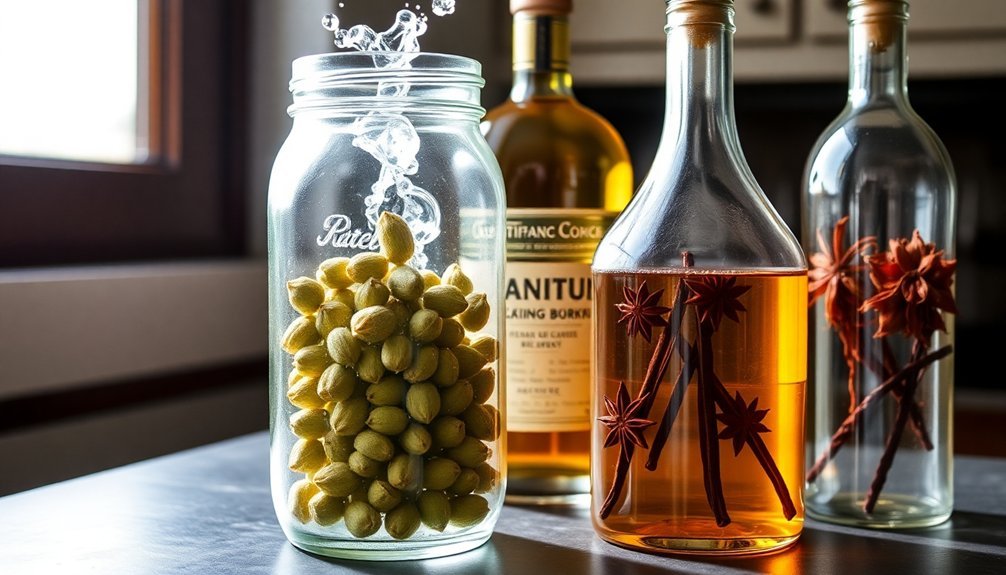
In order to create the best-tasting spice infusions, selecting the right base spirit is essential. You'll want to choose spirits that you'd enjoy drinking on their own, as the quality of your base alcohol directly impacts the final product. Ultra Pure offers six essential bases to help you find the perfect foundation for your infusions.
Consider starting with neutral spirits like vodka, which won't compete with your spice flavors, or opt for gin if you're working with botanicals.
If you're planning to infuse warm baking spices, bourbon or brandy can provide complementary vanilla and caramel notes that enhance your blend. For those interested in creating spiced rum, select a quality rum that'll serve as a sturdy foundation.
When choosing your spirit's proof, remember that higher-proof options (120-190 proof) give you the flexibility to dilute to your desired strength after infusion.
Pay attention to your spirit's origin and ingredients, as these factors influence the final flavor profile. Grain-based spirits differ from potato or grape-based ones, while aged spirits can add complexity through their oak and tannic notes.
Don't forget to check that your chosen spirit is compatible with your intended infusion time and storage container to guarantee the best results.
Match Spices With Compatible Alcohol
Success in spice-infused spirits relies heavily on pairing the right spices with compatible alcohols. When you're working with delicate spice flavors, choose vodka as your base spirit. Its neutral profile won't compete with your spices, making it perfect for shorter infusions that highlight bright, sharp flavors.
For deeper, more complex spice combinations, turn to whiskey or dark rum. These aged spirits add their own sweet, rounded notes that complement and enhance strong spices. They're particularly well-suited for longer infusions, where the flavors can meld together over months. Store your infusions in a dark cupboard location for optimal results.
Consider your spice's surface area when planning your infusion. Ground spices will infuse more quickly than whole ones, but they'll leave more sediment. You can control this by using spice bags, which make straining easier.
If you're using whole spices, you'll need more time, but you can leave them in longer for stronger flavors.
Monitor your infusion's strength by tasting regularly. Short infusions create subtle flavors, while longer ones develop more complexity. If your infusion becomes too strong, you can always dilute it by adding more of your base spirit.
Proper Container Material Matters
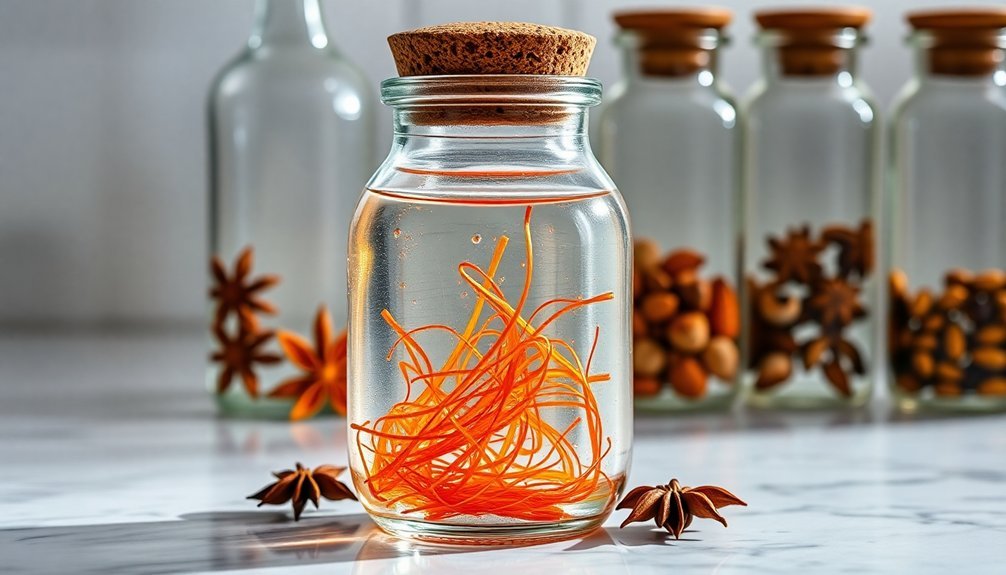
Selecting the right container material plays an essential role in maintaining your spices' freshness and flavor. When choosing containers, you'll need to weigh the pros and cons of each material to guarantee ideal preservation of your spice collection.
Glass containers offer excellent protection against flavor changes and won't react with your spices. While they're breakable, they provide clear visibility and are easy to clean. Their non-reactive material ensures the spices maintain their original taste without any chemical interactions.
Plastic containers, particularly BPA-free and opaque ones, offer durability and protection from light exposure, though you'll need to label them clearly since you can't see inside.
- Glass is ideal if you're storing spices in a cabinet away from direct sunlight and don't have small children who might drop them.
- BPA-free plastic works well if you're concerned about breakage or need lightweight options.
- Metal containers protect against light but can conduct heat, so keep them away from your stove.
- Avoid wooden containers entirely, as they're porous and can affect your spices' quality.
Remember to keep your spices away from heat sources regardless of container choice, and guarantee all containers have airtight seals to maintain freshness.
Temperature Control During Storage
Maintaining your spices at a consistent room temperature around 20°C will help preserve their essential oils and flavors longer than storing them in your refrigerator.
You'll want to keep your spice collection away from any heat sources, including stoves, ovens, and sunny windowsills, as heat exposure can quickly degrade their quality.
To prevent flavor loss, store your spices in a cool, dark pantry or cabinet that's free from temperature fluctuations and far from cooking areas where steam and heat can cause damage.
Ideal Storage Room Range
Your spices' longevity depends heavily on proper temperature control during storage. To maintain peak freshness, you'll need to keep your spices in an environment that's consistently cool, ideally at 20°C (68°F).
Don't let temperatures rise above 70-80°F, as this can lead to rapid flavor deterioration and quality loss.
When choosing a storage location, guarantee it's away from heat sources that could compromise your spices' integrity. A hygrometer can help you monitor both temperature and humidity levels, keeping them within the ideal range of 40-60% relative humidity.
Here's what you'll need to focus on for optimal temperature control:
- Keep spices away from stoves, ovens, and heating elements to prevent exposure to direct heat and steam
- Store your collection in a consistently cool area, avoiding temperature fluctuations that can affect potency
- Consider cold storage (32-45°F) for specific spices like paprika to preserve color and flavor
- Monitor your storage area regularly with a hygrometer to maintain ideal conditions
Remember that temperature stability is vital – even brief exposures to high temperatures can notably impact your spices' flavor and aroma preservation.
Room Temperature Vs Refrigeration
Deciding between room temperature and refrigeration storage can greatly impact your spices' longevity and flavor. For most spices, room temperature storage in a cool, dark place is your best option.
You'll want to keep your spices in airtight containers made of glass, ceramic, or stainless steel, away from direct sunlight and heat sources like stovetops and ovens.
While refrigeration might seem like a good preservation method, it can actually harm your spices due to excess humidity. The moisture in your fridge can cause spices to clump, lose flavor, or even develop mold.
However, there are exceptions – red-colored spices and oil-rich seeds might benefit from refrigeration, especially in hot climates.
If you're storing bulk quantities, consider freezing your spices. You'll need freezer-safe, airtight containers or resealable bags, and it's smart to portion your spices so you're only thawing what you need.
Freezing is particularly effective for preserving ground spices and preventing oil-rich seeds like poppy and sesame from becoming rancid.
Heat Impact Prevention Methods
Proper heat control can make or break your spice collection's longevity. To preserve the potency and flavor of your spices, you'll need to be strategic about where and how you store them. Keep them away from heat-generating appliances like your stove, oven, and dishwasher, as rising steam and high temperatures can degrade their quality.
Choose containers that protect against heat and light intrusion. Your best options include:
- Opaque stainless steel containers with tight-fitting lids
- Dark brown glass jars that block harmful light
- Ceramic containers that maintain stable temperatures
- Airtight containers that prevent moisture infiltration
Maintain your storage environment at room temperature (around 20°C) with relative humidity between 40-60%. You can monitor these conditions using a hygrometer.
When handling spices, work quickly and use dry utensils to prevent moisture from entering the containers. Don't measure spices directly over steaming pots, as this can introduce unwanted heat and moisture.
Select a cool, dry storage location like a pantry or kitchen drawer away from the sink and direct sunlight. This consistent environment will help maintain your spices' flavor and aroma for longer periods.
Filter and Strain Methods
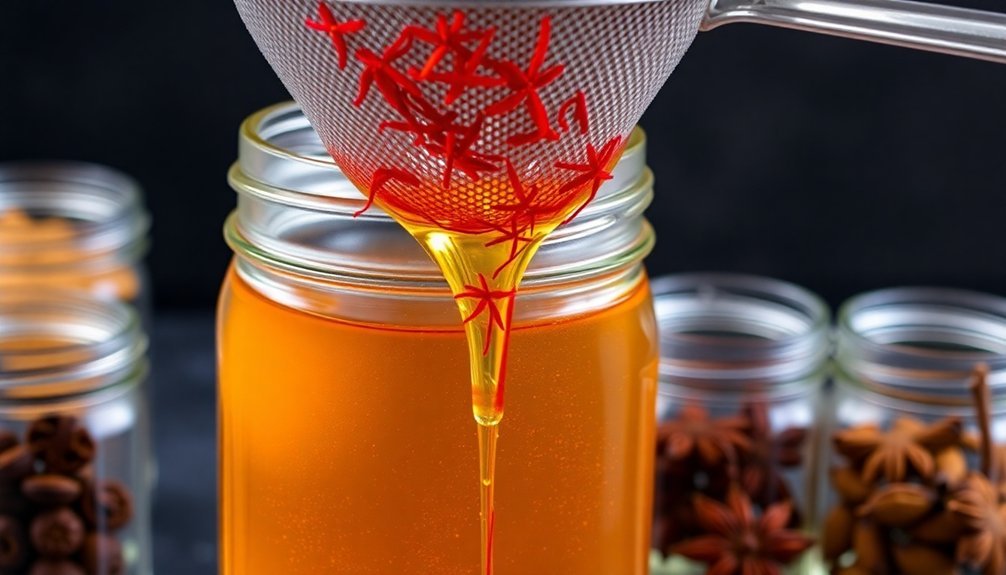
The filtration and straining of spices requires careful attention to preserve their quality and remove unwanted particles. When you're working with alcohol-based spice solutions, you'll want to implement a multi-step filtration process to guarantee the best results.
Start with bag filtration, using a sock-like filter to remove larger particles and debris. This initial step helps protect your subsequent filtration methods from becoming clogged too quickly.
Once you've completed the basic straining, think about using activated carbon filtration if you need to remove any unwanted flavors or impurities. You'll want to dilute your alcohol-based solution to 40-50% ABV before using carbon filtration, using 15-25g of carbon per liter for light filtering or 50-65g for more thorough results.
For the finest results, implement depth filtration to guarantee your spice-infused solution remains clear and stable. This method helps preserve the true colors and flavors of your spices while removing any remaining fine particles.
If you notice any cloudiness, particularly in cold temperatures, you might need to reflect on chill filtration at 26-28°F to remove oils and fatty acids that cause hazing.
Spice-to-Alcohol Ratios
When you're selecting a base spirit for infusing spices, consider that vodka works best for showcasing bright, sharp flavors while whiskey complements warm, sweet spices.
You'll want to start with precise herb measurements, following a basic 1:2 ratio of herbs to alcohol to maintain balanced flavors.
Remember that dried herbs pack more punch than fresh ones, so you'll need to adjust your measurements accordingly if switching between the two forms.
Base Spirit Selection Guide
Selecting an ideal base spirit for spice infusions starts with understanding how different alcohols interact with your chosen flavoring agents. Vodka's neutral profile makes it your safest choice, especially if you're new to infusing spices. It won't compete with your chosen flavors and allows for clean extraction of the spice's essential oils.
For more adventurous infusions, consider these spirit categories based on your spice selection:
- Vodka works universally with most spices, from cinnamon to cardamom, using a 1:3 spice-to-alcohol ratio.
- Gin pairs exceptionally with fennel, juniper, and other botanical spices, but use less spice due to gin's existing flavor profile.
- Rum complements warm spices like vanilla, nutmeg, and clove, requiring minimal amounts due to their potency.
- Bourbon works well with robust spices like mesquite and pecans, following a conservative ratio to avoid overwhelming the spirit.
When working with darker spirits like bourbon or brandy, you'll want to carefully match your spices to complement their existing caramel and toasted notes.
Remember that stronger spices like cinnamon and clove require considerably smaller ratios than milder options to achieve balanced flavors in your infusions.
Herb Measurement Basics
Having chosen your ideal base spirit, measuring precise herb-to-alcohol ratios becomes your next step for successful infusions. You'll need to take into account whether you're using dried or fresh herbs, as this greatly impacts your measurements and alcohol strength requirements.
For dried herbs, stick to a 1:5 ratio (one part herb to five parts alcohol), using 40-60% ABV spirits. With fresh herbs, you'll want a 1:2 ratio and higher proof alcohol (67.5-70% ABV) to account for the natural moisture content. Remember to measure by weight, not volume, for accuracy.
| Herb Type | Recommended Ratio | Alcohol Strength |
|---|---|---|
| Dried | 1:5 | 40-60% ABV |
| Fresh | 1:2 | 67.5-70% ABV |
| Resinous | 1:5 | Up to 95% ABV |
Your extraction time typically runs 2-6 weeks, though some herbs might need several months. Store your infusions in dark glass bottles in a cool place. For potent herbs like lobelia, use a lower ratio (1:10), while resinous plants need higher proof alcohol. If you're working with delicate herbs, take into account using lower alcohol percentages and shorter steeping times.
Monitor Color Changes
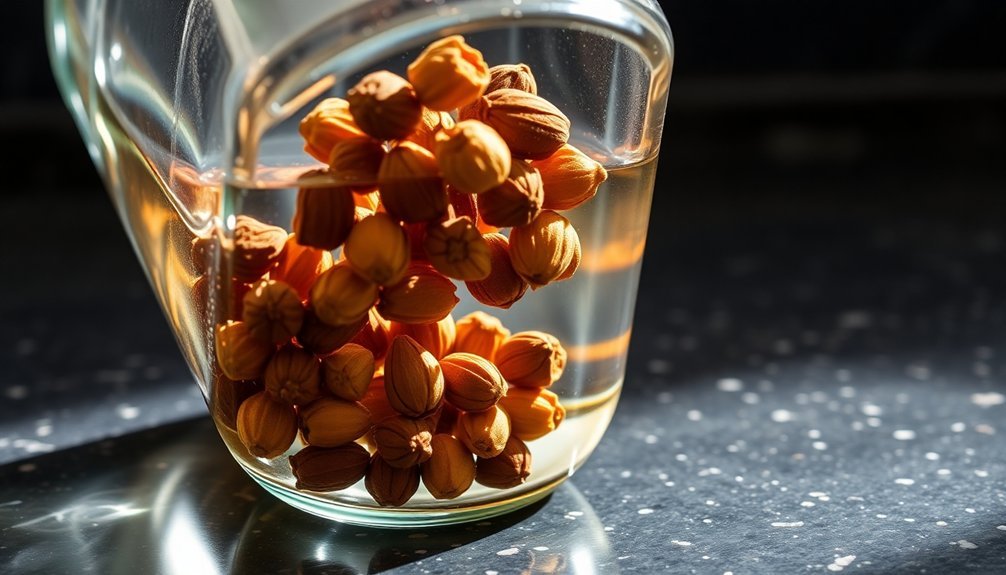
One of the most reliable ways to determine if your spices are past their prime is to monitor their color changes. When spices lose their vibrant hues, they're also losing their potency and flavor. For example, if your chili powder has faded from deep red to a lighter shade, it won't pack the same punch in your dishes.
To properly assess your spices' freshness, you'll want to:
- Compare the current color to a freshly opened container
- Check for any clumping or caking, which signals moisture exposure
- Smell the spice – if there's no fragrance, there's likely no flavor
- Look for signs of oxidation or fading from light exposure
You can prevent premature color changes by storing your spices correctly. Keep them in tightly sealed glass containers away from direct sunlight and heat sources like your stove or oven. A cool, dark cabinet is ideal for maintaining their color and potency.
If you notice significant color degradation or loss of aroma, it's time to replace those spices. Regular visual inspections will help you maintain a fresh, flavorful spice collection that'll enhance your cooking.
Extended Shelf Life Techniques
You'll get the most extended shelf life from your spices by vacuum sealing them in jars, which dramatically reduces exposure to oxygen and moisture.
For an alternative preservation method, you can create alcohol-based tinctures that lock in the flavors and aromatic compounds of your favorite spices.
Both techniques work especially well for preserving whole spices, though you'll want to use dark glass containers to protect them from light damage.
Vacuum Sealing Spice Jars
Mastering the art of vacuum sealing spices can dramatically extend their shelf life and preserve their vibrant flavors. You'll need wide-mouth mason jars, a vacuum sealer with jar attachments, proper lids with rubber seals, and food-grade oxygen absorber packs to get started.
The process is straightforward but requires attention to detail. Begin by ensuring your spices are completely dry and free of clumps. Fill your jars, leaving 1-2 inches of headspace, then add an appropriately sized oxygen absorber pack.
Once you've secured the lid, use your vacuum sealer according to the manufacturer's instructions to remove all air from the jar.
Here's what you'll achieve with proper vacuum sealing:
- Extended shelf life through oxygen removal and prevention of oxidation
- Protected flavors and aromas that stay vibrant longer
- Complete protection from insects and other pantry pests
- Space-efficient storage that's easy to organize
Store your vacuum-sealed jars in a cool, dark place, keeping temperatures below 21.1°C. Don't forget to label each jar with its contents and packaging date.
Alcohol-Based Spice Preservation
Long before modern refrigeration, alcohol proved to be an exceptional preservative for spices, and today it remains one of the most effective methods for extending shelf life. You'll find this method particularly useful when you want to preserve spices for several years while maintaining their essential oils and flavors.
| Process Step | Requirements | Duration |
|---|---|---|
| Preparation | 40-50% alcohol, sanitized jar | 1 day |
| Maceration | Cool, dark storage | 4-6 weeks |
| Filtering | Fine strainer, dark bottles | 1 day |
To create your alcohol-preserved spices, cut them into small pieces and fully submerge them in vodka or Everclear (40-50% ABV) in a clean glass jar. Store the mixture in a cool, dark place for 4-6 weeks, allowing the alcohol to extract the spices' essential compounds. After straining and filtering the mixture, you'll need to maintain at least 25% alcohol content in the final preparation for proper preservation.
Always store your alcohol-preserved spices in airtight, dark glass containers to protect against light and contamination. When done correctly, you can expect your preserved spices to maintain their potency for 3-5 years.
Prevent Oxidation and Degradation
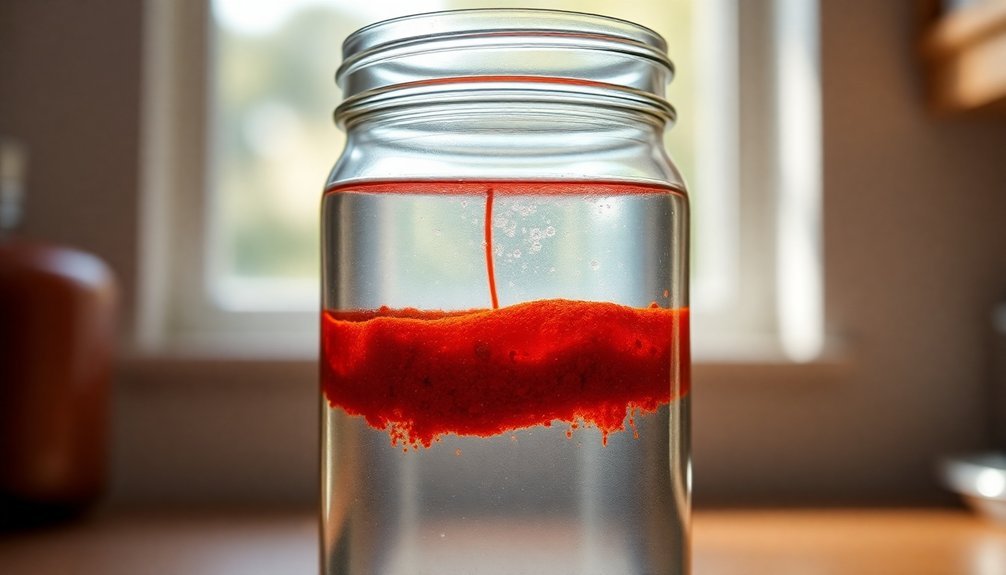
Spices wage a constant battle against their greatest enemies: oxygen and environmental factors. To protect your spices from degradation, you'll need to create ideal storage conditions that minimize exposure to these harmful elements.
Start by choosing the right containers – glass, stainless steel, or ceramic options with airtight seals work best. You'll want to avoid plastic containers since they can transfer unwanted odors and flavors to your spices. When handling your spices, always use dry utensils to prevent moisture from compromising their quality.
Here's what you need to focus on to prevent oxidation:
- Store spices away from direct sunlight and heat sources, including your stove
- Keep containers tightly sealed when not in use to block air and moisture
- Use smaller containers for daily needs and store bulk quantities separately
- Check regularly for signs of degradation like loss of color or aroma
Remember that whole spices can last up to four years when properly stored, while ground spices typically maintain their potency for one to two years.
You'll know it's time to replace your spices when they've lost their distinctive aroma or flavor, regardless of their storage date.
Test for Flavor Intensity
How can you tell if your spices still pack their intended punch? You'll need to engage your senses and follow some testing methods used by professionals. Start by examining your spices visually for any color changes, then conduct a simple aroma test – fresh spices should release a strong, distinctive smell when crushed or rubbed between your fingers.
To test flavor intensity more precisely, you can create a controlled taste test. Place a small amount of the spice in warm water or a neutral-tasting base, and compare it with a fresh sample of the same spice. You'll want to evaluate specific flavor attributes like sweetness, bitterness, or heat level.
If you're testing multiple spices, cleanse your palate between samples with water or plain crackers. Remember that temperature affects how you perceive flavors, so test your spices at the temperature you'll typically use them.
Professional tasters use flavor wheels to categorize tastes, but you can simply rate the intensity on a scale of 1-5. If your spices don't produce distinct flavors or aromas, they've likely lost their potency and should be replaced.
Frequently Asked Questions
Can I Reuse the Alcohol-Preserved Spices for Cooking After Infusion?
Yes, you can reuse alcohol-preserved spices in cooking, but they'll have reduced potency. Just strain them and add them to your dishes, or use them along with their infused alcohol for extra flavor.
Will Alcohol-Preserved Spices Affect the Taste of Non-Alcoholic Dishes?
When you use alcohol-preserved spices, they'll add flavor complexity to your non-alcoholic dishes. Most alcohol cooks off during preparation, leaving behind enhanced spice flavors without greatly impacting the dish's alcohol content.
How Do I Adjust Recipes When Using Alcohol-Preserved Spices?
When you're using alcohol-preserved spices, start with half the amount called for in recipes. You'll need to taste and adjust as you cook since the alcohol extraction can intensify the spice flavors.
Can I Mix Different Types of Spices in the Same Alcohol Container?
Yes, you can mix different spices in one alcohol container. Just guarantee the flavors complement each other and start with small amounts. Consider common pairings like cardamom-cinnamon or cloves-allspice for best results.
Are There Specific Spices That Should Not Be Preserved in Alcohol?
You'll want to avoid using ground spices, as they'll make your alcohol cloudy. Also, skip fresh herbs that spoil quickly, highly oily spices that can turn rancid, and extremely potent peppers like Carolina Reapers.
In Summary
You've learned the key techniques for preserving your favorite spices in alcohol. By selecting quality spirits, matching flavors thoughtfully, and following proper storage methods, you'll maintain their potency for months longer than traditional dry storage. Don't forget to monitor your infusions regularly and test for flavor changes. With these tips, you'll always have fresh, aromatic spices ready for your culinary adventures.

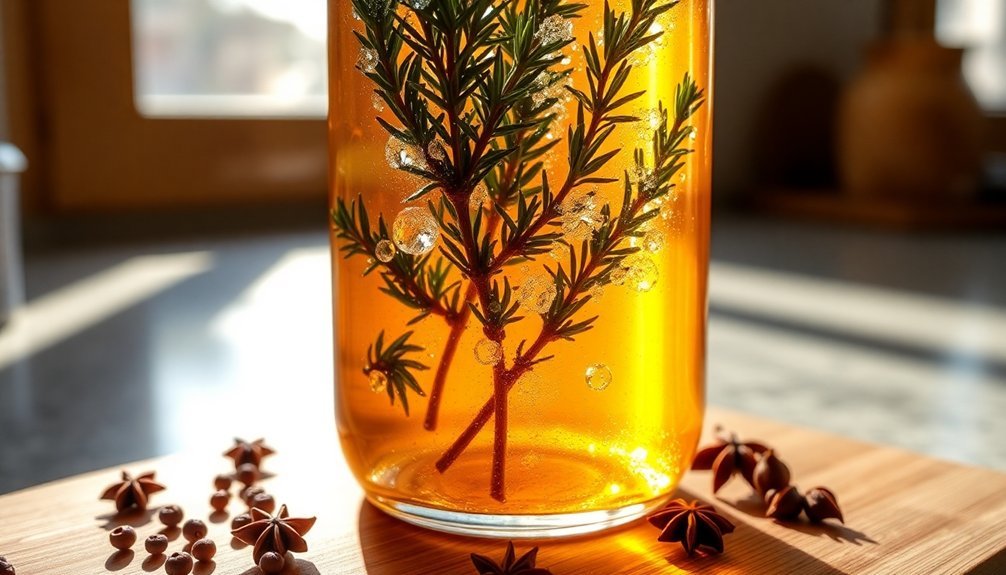



Leave a Reply